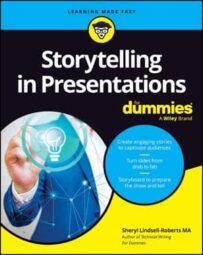- Stories engage the audience and evoke emotion responses.
- They make information more relatable and memorable.
- They can increase retention and make messages more compelling.
- And they help build trust between the presenter and the audience.
Guidelines for a great presentation
The first order of business is to build up your repertoire of stories. Once you’ve done that, here are some guidelines for a powerful delivery:
- Name your characters. Audiences identify with actual names more than titles.
- Say: Genna, our wonderful presenter, suggested . . .
- Rather than: The presenter suggested . . .
- Give a brief description of the person or surroundings to make the story real.
- Say: The room wasn’t brightly lit, but I found a seat near the window.
- Rather than: I entered the room and sat down quietly.
- Speak in the present to make your narrative more immediate.
- Say: I walk into the room, and what do you think happens?
- Rather than: When I walked into the room and what do you think happened?
- Include sensory information (what you saw, felt, tasted, heard, or smelled).
- Say: The cold air felt like shards of glass in my lungs.
- Rather than: It was cold outside.
- Talk about what is and what can be.
- Say: The Q4 numbers must be stronger than 5% for robust year-end bonuses.
- Rather than: We missed our Q3 forecast by just 5%.
- Show or describe, don’t just tell.
- Say: With the sizzling heat of the midday sun on my forehead, I wish had brought my sunhat.
- Rather than: It was very hot outside.
Here are some more guidelines about what your audience sees:
- Gesture with your hands to coordinate with your words. If you’re not talking with your hands, you’re not talking. Use gestures as naturally as you would during a conversation with friends.
- Maintain eye contact. This builds rapport between you and your audience and keeps them engaged.
- Listen to your audience. Listen with your eyes as well as with your ears.
- Are they alert?
- Are they checking their phones?
- Are they having side conversations?
- Do you hear wood sawing (another way of saying snoring) around the room?
- Be present, organized, animated, energetic, poised, and focused. Be aware of these qualities in other presenters. If you don’t go to many presentations, view a few TED talks.
Avoid the seven deadly slide sins
Eliminating the following chronic blunders gives you a leg up in nailing your next important talk. Here are the top seven deadly sins of slide presentations:
- Slide transitions: You know the fade-ins, fade-outs, wipes, blinds, dissolves, checkerboards, cuts, covers and splits, and builds. It’s fine to use a few appropriately, but focus on your message, not on gimmickry.
- Too much clipart: You may find an appropriate piece of clipart that “just says it,” and that will work. But don’t use too many because clipart has become a visual cliché and lacks creativity. There are many photo sites from which you can grab appropriate visuals. For free check out Unsplash, Pixabay, Pexels, and Burst. For a fee check out Adobe Images, Shutterstock, and Getty.
- Distracting templates: Templates force you to fit your presentation into a pre-packaged mode. Create your own distinctive look and use your company logo in a corner of the screen. (If your company has a prescribed template, you must go along to get along.)
- Test-laden slidezillas: Avoid paragraphs, long quotations, and complete sentences. Limit each slide to one point and no more than 5 lines of text.
- Bad color schemes: If you use inappropriate or flashy colors, your presentation will look tacky. Stick with grays and dark shades of blue or green. Use what’s professional for your audience, your company, and your theme while also providing accessibility for all.
- Too many elements: Charts, tables, graphs, and bullets are fine, but don’t go overboard. Your audience won’t have patience for deciphering all sorts of colors, trend lines, and one bulleted list after another.
- Too many charts and tables: Nothing kills a presentation like data overload. Keep charts and tables to a minimum and show only those that are necessary to make a key point.
The start-up brief
Every presenter must remember four important words: It’s not about me! When your audience walks into the room, they’re thinking, “What’s in it for me?”
Perhaps you think you already know your audience, but do you actually understand their (hidden) agendas or what keeps them up at night?
This Start-Up Brief (also shown below) can help you find out how to better understand your audience, their purpose and key issue, and the questions you need to address to create a presentation that will make each person feel like you’re speaking directly to them.
Start-Up Brief
Audience:
- What’s the key issue — the one takeaway message I want my audience to remember?
- Who’s my primary audience?
- What does my audience need to know about the topic?
- What’s in it for my audience?
- Does my story need a special angle or point of view?
- What will my audience’s reaction be toward the topic? Positive? Neutral? Negative?
Purpose
My purpose is to___________________ so my audience will ___________________.
Questions
What who, what, when, where, why, and how questions will my audience want answered?

